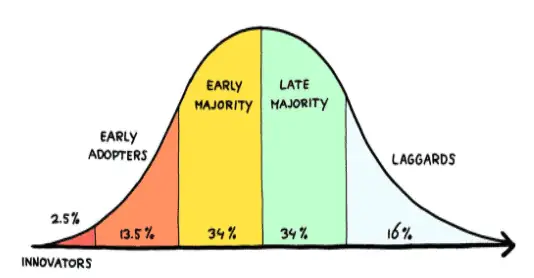Change management is something that many companies struggle with. Why? Because change management communication isn’t easy. Getting employees to accept, adopt, and maintain a change can be really difficult without good internal communication. But it doesn’t have to be. That’s why we’re sharing a few strategies and best practices to help you communicate change more effectively.
What is Change Management?
Before we can effectively create a change management communication strategy, we have to understand what change management is.
Change management is a strategic approach that focuses on guiding an organization and its employees through a change. It involves planning, executing, and monitoring initiatives that facilitate successful transitions, whether they involve new technologies, processes, systems, or company values.
At its core, change management recognizes that businesses are made of people. And these individuals play a critical role in embracing and adapting to change. At PRSA Connect 2022, one of the speakers, Jim Heininger, said it best: “Organizations don’t change. People do.”
That’s why proper change management involves acknowledging the human aspect of change and actively working to address the challenges and resistance that employees will encounter during periods of transformation.
Key Components of Change Management
To effectively manage change, you’ll need a few strategic tools.:
- Clear vision and goals. Change initiatives require a clear vision and well-defined objectives that outline the desired outcomes. This provides a sense of direction and purpose for employees, helping them understand the importance and benefits of the change.
- Effective communication. Communication is the backbone of change management. It involves creating a robust change management communication strategy that keeps employees informed about the change, addresses their concerns, and provides ongoing updates throughout the process.
- Training and support systems. Change often requires new skills and knowledge. Providing adequate training and support to employees equips them with the capabilities to adapt to the change effectively.
- Measurement. Establishing feedback mechanisms allows you to assess the effectiveness of your change management efforts. Regularly monitoring progress, evaluating outcomes, and seeking employee feedback provide valuable insights for continuous improvement and adjustment of the change strategy.
Benefits of Change Management
Change management sounds like a lot of work, right? Well, here’s why it’s worth it.
- Lower resistance. Change management techniques help minimize resistance by addressing concerns, building trust, and fostering a supportive environment.
- Increased engagement. By involving employees in the change process, you can boost employee engagement and foster a sense of ownership and commitment.
- Sustained results. Change management techniques focus on ensuring employees understand the change, its purpose, and the benefits it brings. This understanding leads to better adoption of the change and increased sustainability of the desired outcomes.
- Enhanced agility. With change management practices in place, companies become more adaptable and agile in responding to market dynamics, customer demands, and emerging opportunities.
What is Change Management Communication?
Change management communication, or change communication, is all the ways that we share messages and help our companies through transformation or change. Successful communication will share why a change is being made and clearly define how it will impact each employee group.
But when we think about communicating change, it’s not a linear process and then you’re done! We might wish that was the case, but the reality is, to get changes to stick, we need a change management communication plan that continues to reinforce and reiterate the desired behavior.
The Purpose of Change Management Communication
The primary purpose of change management communication is to:
- Share the why. Communicating the rationale behind the change is crucial for employees to understand the reasons and objectives driving the transformation. This involves clearly articulating the business case, the benefits, and the impact of the change on individuals, teams, and the organization as a whole. When employees grasp the “why” behind the change, it helps create a sense of purpose and aligns their efforts with the broader goals.
- Address concerns and resistance. Change often brings about uncertainty and resistance from employees who may fear the unknown or feel uneasy about the potential implications on their roles or job security. Effective change management communication acknowledges these concerns and actively addresses them. It provides a platform for open dialogue, encourages questions and feedback, and offers support to alleviate anxieties and build trust.
- Involve employees. Change management communication involves engaging employees throughout the change process. It includes opportunities for two-way communication, such as town hall meetings, focus groups, workshops, and digital platforms, where employees can express their thoughts, share ideas, and contribute to decision-making. Actively involving employees helps foster a sense of ownership, empowerment, and commitment to the change initiative.
- Sustain momentum and reinforce changes. Change management communication goes beyond the initial announcement or rollout. It involves a sustained effort to reinforce and embed the change within the organization’s culture and day-to-day operations. This includes ongoing communication campaigns, reminders, updates on progress, and celebrating milestones to keep the change top of mind and maintain momentum.
Elements of an Effective Change Management Communication Plan
To develop an effective change management communication plan, you’ll need:
- Clear and consistent messaging on a deliberate cadence.
- A targeted approach to sharing key messages with employee groups.
- Multiple channels to share and reinforce messages.
- Feedback mechanisms to collect real-time input on how the comms plan is going.
- Training materials for each phase of the change.
- Manager materials to help them reinforce the change with their direct reports.
Change Management Communication Strategy
Several change management frameworks can be beneficial when putting together your communication plan.
The Prosci ADKAR® Model
We like the Prosci ADKAR® model for change management communication because it helps break down communication needs into stages. But, perhaps most importantly, it also prescribes that there is a period of reinforcement that may be ongoing depending on the complexity of the change.
So, what is ADKAR?
- Awareness: initial communications to let people know a change is happening
- Desire: sharing why the change matters and how it benefits your employees to get your people on board with the change
- Knowledge: teaching teams what they need to know to change successfully
- Ability: actually helping employees enact the desired behavior change
- Reinforcement: ongoing communication to remind employees of the change and what is expected of them
Technology Adoption Curve
In our business, we talk about the technology adoption curve a lot! This model shows how and when people get on board with new technology.
In fact, getting employees to adopt new systems and tech is a major type of change in most organizations. So, this model for behavior and why certain groups are slower to get on board is really helpful when crafting and targeting your messages.
Whenever you roll out a new piece of software or technology, employees will fall into one of a few groups:
- Innovators: These are your super users. Your champions of change. They want what’s new because they like being first, and they are the rare few who like change and disruption. It’s great if you can find these people in your organization and tap them to help you gain momentum early on during a change.
- Early Adopters: These are highly engaged people who aren’t as resistant to change as some. They are likely to want new tools that solve their problems, even if it means shaking up how they’ve done things.
- Early Majority: Like your early adopters, this group is more engaged, and with a little convincing (the WIIFM—what’s in it for me?), they will be on board.
- Late Majority: This group wants some proof before they make any changes. They want to see the first 50% of the company use a new tool or system successfully before they’re on board. And sometimes, they just need to be told “This is mandatory” to take the plunge.
Change Agility Methodology
This method looks at change from the perspective of ensuring your company can be agile by taking a thoughtful approach to change. There are four stages:
- Purpose. This is where you define why you are changing. Remember that different groups within your company might have a different “why.”
- Design. This is where you bring a cross-section of employees together from your company to work together on a change program.
- Pilot. We are often so eager to make changes, that sometimes we forget this step. But this is one of the most important things we can do to assess if a change is right for our company and to work out any kinks in messaging or providing the proper support to impacted teams. Be prepared to discover that a change is a bad idea during the pilot phase. Don’t force changes if they fail in a pilot.
- Deploy. Deploy doesn’t just mean pushing out a change and calling it a day. This phase requires you to continue collecting feedback, monitoring progress, and celebrating wins.
Change Management Best Practices
Regardless of what model or framework you use, there are a few best practices that will set you up for success.
- Create feedback loops. People are far less resistant to change if they feel like they were involved in the process. If you consult focus groups and leaders across the organization before pushing changes out from the top, you are more likely to win them over. And BONUS, they might actually point out flaws in your plan before you get started, saving you time and resources.
- Define the type of change. Is the change core, transitional, or transformational? Who is really being affected? What barriers might exist? Answering these key questions upfront will help you craft your strategy.
- Develop personas for impact analysis. Sit down with all the major stakeholder groups and interview them to really understand their needs and how the change will impact them. Then use these personas to develop the messaging for each group. Not all groups will require the same level of detail or support, which will help you define that.
- Measure and keep checking in. Even if you do your research upfront and get employee feedback, continuous measurement and check-ins with teams will help you ensure a change is rolling out the way you expected.
“If you affect change by starting with the early adopters, the majority won’t just go along with it, they’ll demand it.” – Simon Sinek
[optin-monster slug=”lxokfrxik2s4wvdmsoif” followrules=”true”]
Creating a Holistic Change Management Strategy
Outside of individual change campaigns, it’s important to look at change from a high level.
- How much change is happening within your organization? Is it enough to be overwhelming to your teams? Are you changing systems too often and too quickly rather than taking longer to pick the right solutions?
- What is the mindset towards change at your company? There’s a great Socrates quote that says, “The secret of change is to focus all of your energy, not on fighting the old, but on building the new.” At your company, how do people feel about change? How do you approach it? Are you focused on solving problems and making the right choices, or are changes happening for the sake of change?
While it might sometimes be out of your control, as the communications team, you have the ability to highlight when too many changes are being made at once. To be a strategic advisor, sometimes you have to be the person to say, “We are asking our field teams to do too much,” and to share that feedback from the field. Properly cadencing change and shifting the collective mindset towards it within your company can often be key to helping changes happen successfully.
[optin-monster slug=”gqorn0natkqgyrtjvr6i” followrules=”true”]
Comments are closed.








